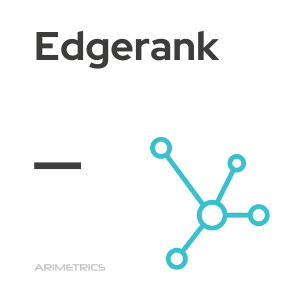
Definition:
EdgeRank is Facebook’ s initial algorithm designed to determine which posts were the most relevant and should be displayed with the most visibility in users’ newsfeeds. This algorithm is based on three key criteria:
- Affinity: Refers to the degree of interaction that fans have with a page. The more interaction there is between users and the page, the higher the affinity. This means that posts from pages with which users interact frequently are more likely to appear in their feeds.
- Interest (or weight): This criterion evaluates the importance of a publication based on the number of “likes” and times it has been shared. The greater the interaction with a publication, the greater its weight, which increases its visibility.
- Time: The most recent posts have priority over older ones. As time passes, publications lose relevance, which means that the most recent updates are more visible.
While EdgeRank was Facebook’s first algorithm, the platform has progressed considerably, and the current algorithm is much more advanced.
Evolution of the Facebook algorithm
The term“EdgeRank” refers to Facebook’s original algorithm, designed to determine which posts would be displayed in users’ news feeds. While EdgeRank was critical in the early days of Facebook, the platform has evolved significantly, and the current algorithm is much more sophisticated.
- Transition from EdgeRank to advanced algorithms: While EdgeRank focused primarily on three basic factors: affinity, interest (or weight), and time, Facebook’s current algorithm incorporates a much broader range of signals. These include content quality, previous user interactions, source diversity, and content context.
- Enhanced personalization: Today, Facebook’s algorithm uses artificial intelligence to analyze thousands of factors, offering users a highly personalized news feed. This means that each user sees a unique set of posts, tailored to their interests and behaviors on the platform.
- Focus on quality content: Facebook has placed a greater emphasis on displaying high quality content that is relevant and meaningful to users. This includes prioritizing posts from friends and family, as well as content that generates meaningful interactions.
- Continuous updates: Facebook continues to tweak and improve its algorithm to respond to users’ changing needs and to encourage more authentic and positive interaction on the platform.
Strategies to improve visibility on Facebook
Although EdgeRank is no longer used, understanding the principles of Facebook’s current algorithm is crucial to improving the visibility of posts:
- Encourage interaction: Create content that invites comments,“likes” and shares. Open-ended questions, polls and engaging multimedia content tend to generate more interaction.
- Post regularly: Maintaining a consistent posting frequency helps to keep the page active and increase affinity with followers.
- Optimize posting time: Analyzing when followers are most active on the platform and scheduling posts for those times can increase visibility.
Impact of the algorithm on digital marketing
The Facebook’s algorithm has a significant impact on digital marketing strategies:
- Organic reach: A good understanding of the algorithm can increase the organic reach of posts, reducing the need to invest in paid advertising.
- Audience segmentation: Understanding how the audience interacts with the content allows adjusting segmentation strategies and message personalization.
- Measuring results: Analyzing the performance of content helps to measure the effectiveness of campaigns and make adjustments based on concrete data.
As social media platforms evolve, so do their algorithms:
- Increased personalization: Algorithms are expected to continue to evolve towards greater personalization, displaying content that is increasingly tailored to users’ individual interests.
- Artificial intelligence integration: Artificial intelligence will play an increasingly important role in improving algorithms, enabling a deeper understanding of user behavior.
- Emphasis on quality content: Platforms will continue to prioritize content that offers real value to users, encouraging the creation of authentic and relevant content.
